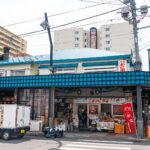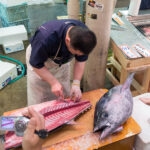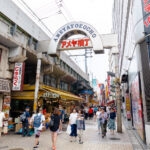This post may contain affiliate links. Please read our disclosure policy.
From sea grapes to pork belly, Okinawan food marries island flavors, family recipes, and culinary roots into a cuisine unlike any other in Japan.

First Makishi Public Market (第一牧志公設市場): A Feast for the Senses
Makishi Public Market in Naha City is just a block off the busy Kokusai Dori. First opened in 1950, this two-level market is a lively hub for fresh seafood, island-grown vegetables, and local specialties.
The outdoor arcade was a fun place to wander. We spotted salt-flavored soft cream, chewy muchi (Okinawan mochi), and even popo, a thin crepe filled with brown sugar. Inside the market building, vendors showed off trays of fresh pork, colorful reef fish, and tubs of bright mozuku seaweed.
One of the highlights here is the mochiage service. You pick your seafood downstairs and take it to one of the upstairs restaurants to have it cooked. We tried sashimi-style butterfly fan lobster, grilled turban snails, scallops, shrimp, and miso soup made from the lobster shell.
Tip: Be ready to negotiate prices. We likely overpaid and wished we had researched a bit more before ordering.
Nagumagai Restaurant (名護曲レストラン): Comfort Food on the Coast

While driving up the coast near Nago City, we stopped at Nagumagai Restaurant, a low-key spot that felt more like a local diner than a formal restaurant. It’s part eatery, part market, and serves real Okinawan home cooking.
Our favorites were:
- Rafute – Pork belly simmered in soy and awamori, rich and tender
- Mozuku Tempura – Lightly fried seaweed fritters with a satisfying crunch
- Goya Champuru – A bitter melon stir-fry with tofu and scrambled egg
- Soki Soba – Thick wheat noodles topped with braised pork rib
- Umibudo (sea grapes) – Tiny, briny pearls that pop with each bite
- Jushii – Seasoned rice that reminded us of a cross between pilaf and stuffing
It was casual and cozy, just the kind of roadside stop that hits the spot during a long day of exploring.
Onnanoeki Nakayukui Market (おんなの駅「なかゆくい市場」)

Another roadside stop we tried was Nakayukui Market in Onna Village. This rest stop-style market was packed with food stalls, souvenir stands, and live seafood tanks.
We tried warm bowls of Okinawa soba and a few flavors of sata andagi—Okinawan-style donuts that are crispy on the outside and cakey inside. Inside the shop, we browsed a wide range of local snacks:
- Red yam pies and black sugar sweets
- Salted rice crackers and Okinawan “snow salt”
- Bottles of awamori rice liquor
- And even jars of habu snake liquor on display
Yoshizaki Cafeteria (吉崎食堂): Our Favorite Meal in Okinawa

Our favorite dinner on the island came from Yoshizaki Cafeteria, an izakaya-style restaurant with two locations in Naha. The name makes it sound like a school cafeteria, but it was anything but. The space was warm, stylish, and packed with locals enjoying a casual night out.
Here’s what we ordered and loved:
- Jimami Tofu – Silky peanut tofu with a delicate sweetness
- Crispy Goya Chips – A clever way to enjoy bitter melon
- Spicy Pork Hot Pot – Great for sharing with the whole table
- Umibudo (again!) – Yes, we were obsessed
- Sashimi platter and chicken skin cracker – Crunchy, salty, addictive
- Braised Pig Feet – Tender, flavorful, and surprisingly elegant
Everything came out beautifully plated and full of bold flavor.
Our Final Take on Okinawan Food

Okinawan cuisine has a personality all its own—bold, savory, and deeply tied to the land and sea. Every bite carries the flavors of local ingredients and the weight of traditions passed down for generations.
You also taste the island’s layered history. After World War II, American influence brought in ground beef, cheese, and canned meat, sparking new creations like taco rice—taco-seasoned meat, lettuce, and tomato over fluffy steamed rice. It’s humble, filling, and somehow feels perfectly at home here.
For us, dishes like rafute, sea grapes, Okinawa soba, and taco rice are snapshots of Okinawa’s spirit. They tell a story of resilience, creativity, and a delicious harmony between the old and the new.
More to Explore Nearby
After sampling Okinawa’s unique dishes—from rafute to Okinawa soba—balance your foodie adventures with these cultural and scenic stops across the island.
- Shuri Castle – Walk through the restored royal palace of the Ryukyu Kingdom and learn how Okinawan history shaped its cuisine and culture.
- Yomitan Pottery Village – Watch local artisans craft traditional ceramics in this peaceful hilltop village surrounded by greenery.
- Orion Happy Park – Take a free brewery tour of Okinawa’s beloved Orion Beer, complete with a tasting of fresh pours.
- Okinawa World – Explore Gyokusendo Cave and learn about traditional crafts and food culture at this family-friendly cultural theme park.




